Sapphire Atlantis
RADEON 9700 &
RADEON 9700 PRO Ultimate Edition Video Cards Review
|

Contents
-
General
information
-
Peculiarities
of the video cards
-
Test system
configuration
-
Test
results: 3DMark2001 SE game tests
-
Conclusion
As you know, new ATI's products are expected approximately in the middle
of spring, and now we are still going with the RADEON 9700 and 9700 PRO
as they are in product lists of a great number of companies.
As you know, Sapphire Technologies is actually the main partner of ATI
in the video card sphere. This company produces the broadest line on the
ATI's processors. The company is based in Hong Kong but is a daughter enterprise
of PC Partner which is the greatest Chinese components manufacturer and
an old partner of ATI (today all video cards "Built by ATI" are produced
at the PC Partner's plants).
Today we have two senior models from this firm. One of them - Atlantis
RADEON 9700 PRO - was already reviewed before. By the way, here is the
list of the video cards based on the RADEON 9500/9700 which were also already
reviewed.
-
Analyses of
architecture of the RADEON 9700 and Microsoft DirectX 9.0
-
ATI RADEON 9700
Pro 128MB review
-
MAYA II R9700Pro
128MB - performance estimated on the new testbed based only on the
Pentium 4 2.53 GHz, comparison with the NVIDIA's 40.41 driver
-
Hercules 3D Prophet
9700 Pro 128MB - performance of the new CATALYST 2.3 driver estimated
in 3DMark2001 SE, and Unreal Tournament 2003 DEMO final release
-
PowerColor Evil
Commando2 RADEON 9700 Pro 128MB - performance of the new CATALYST 2.3
driver estimated in game tests, 3D quality issues
-
Sapphire Atlantis
RADEON 9700 Pro 128MB - detailed analyses of anisotropic filtering
of the RADEON 9700
-
ATI RADEON 9700,
RADEON 9500 64MB and Gigabyte MAYA II RADEON 9500 64MB
-
Sapphire
Atlantis RADEON 9500 128MB - RADEON 9500 128 MB has a 256bit memory
bus! Tests of the video cards in the DOOM III
-
HIS Excalibur RADEON
9700 Pro and tests in the DirectX 9.0 RC0
-
ATI RADEON 9500 PRO
- 128 bit memory bus and buffer compression at AA (virtual 256bit bus)
- ATI RADEON 9500 64MB, 9500 128MB, 9500 PRO,
9700 and 9700 PRO in DirectX 9.0: Part 1 - Game tests and 3DMark2001, as well
as Soft9700!
- ATI RADEON 9500 64MB, 9500 128MB, 9500 PRO,
9700 and 9700 PRO in DirectX 9.0: Part 2 - Tests in DirectX 9.0 - synthetic tests
from RightMark 3D
- YUAN XpertVision RADEON 9000 64MB and RADEON 9700
PRO
Now we return to the RADEON 9700 PRO, namely to a new revision of this
card - Ultimate Edition - which is equipped with a fanless cooler from
Zalman. This is a big device meant to provide proper cooling for the card
(RADEON 9700 PRO heats much) and letting a user rest from noisy fans.
In the tests you will see the Sapphire's RADEON 9700 card which was
the first to have a black PCB. This is actually a standard reference based
card.
Cards
| Sapphire Atlantis RADEON 9700 |
| The card has AGP X2/4/8 interface, 128 MB DDR SDRAM located in 8 chips
on both PCB sides.
The Hynix's memory chips have 3.6ns access time which corresponds to
275 (550) MHz, but the memory runs at 270 (540) MHz. The GPU works at 275MHz
which is typical of RADEON 9700.
|

|
| Sapphire Atlantis RADEON 9700 PRO 128MB Ultimate Edition |
| The card has the same AGP X2/4/8 interface and the same 128 MB DDR
SDRAM.
The Samsung's memory chips have 2.8ns access time which corresponds
to 350 (700) MHz, but the memory runs at 310 (620) MHz. The GPU works at
325MHz. |

|
| Comparison with the reference design, front view |
| Sapphire Atlantis RADEON 9700 |
Reference card ATI RADEON 9700 |

|

|

|
| Sapphire Atlantis RADEON 9700 PRO 128MB Ultimate Edition |
Reference card ATI RADEON 9700 PRO |

|

|

|
| Comparison with the reference design, back view |
| Sapphire Atlantis RADEON 9700 |
Reference card ATI RADEON 9700 |

|

|
| Sapphire Atlantis RADEON 9700 PRO 128MB Ultimate Edition |
Reference card ATI RADEON 9700 PRO |

|

|

|
|
These are the entire copies of the reference design, and such cards
were much spoken about before. Just note that the PCB's black color would
go better with a silvery big heatsink than with a red one. According to
Sapphire, all new RADEON 9700/Pro based cards will have a black PCB.
The most noteworthy feature of these cards is the coolers.
|
And now look at the processors themselves.
RADEON 9700:

RADEON 9700 PRO Ultimate Edition:
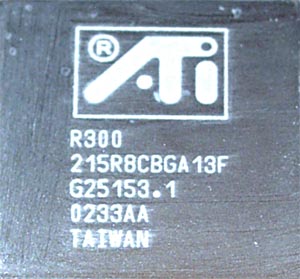

We have the same chipset just working at different frequencies. By the
way, it's also the same on the RADEON 9500, - only it has half of its pipelines
locked on the software level.
Overclocking
| Sapphire Atlantis RADEON 9700 |
275/540 -> 355/610 MHz |
| Sapphire Atlantis RADEON 9700 PRO 128MB Ultimate Edition |
325/620 -> 350/694 MHz |
The overclocking is not bad taking into account the originally low frequencies
of the RADEON 9700 and a missing cooler on the Ultimate Edition.
Note that:
-
during the overclocking you should provide additional cooling, in particular,
for the card (first of all, for its memory):

-
overclocking depends on a sample, and you shouldn't generalize the results
of one card to all video cards of this trade mark or series. The overclocking
results are not the obligatory characteristics of video cards.
Test system and drivers
Testbeds:
-
Pentium 4 3066 MHz based computer:
-
CPU: Intel Pentium 4 3066 MHz;
-
Mainboard: ASUS P4G8X (iE7205);
-
RAM: 1024 MB DDR SDRAM;
-
HDD: Seagate Barracuda IV 40GB;
-
OS: Windows XP SP1;
-
Monitor: ViewSonic P810 (21") and ViewSonic P817
(21").
-
ATI Drivers v6.255.
VSync is off in the drivers, the texture compression is off in applications.
The texture detail level is set to High Quality.
The results of the following video cards are given for comparison:
-
Albatron Medusa GeForce4 Ti 4600 (300/325 (650) MHz, 128 MB, driver 42.86);
Test results
Before we start examining 2D quality I should say that there is no a complete
technique of objective estimation of this parameter because:
-
Almost all modern 3D accelerators can have 2D quality much dependent on
a certain sample, and it's impossible to trace all cards;
-
2D quality depends not only on a video card, but also on a monitor and
a cable;
-
Besides, certain monitors do not get along with certain video cards.
As for the tested samples, together with the ViewSonic P817 monitor
and BNC Bargo cable the cards showed excellent quality at the
following resolutions and frequencies:
| Sapphire Atlantis RADEON 9700 |
1600x1200x85Hz, 1280x1024x120Hz, 1024x768x160Hz |
| Sapphire Atlantis RADEON 9700 PRO 128MB Ultimate Edition |
1600x1200x85Hz, 1280x1024x120Hz, 1024x768x160Hz |
In 1280x1024@75Hz there were some ripples on the monitor with the
RADEON 9700 card which depended on what a user was doing. At other resolutions
and frequencies such artifact wasn't noticed. I think Sapphire should respond
to it.
3D graphics, 3DMark2001 game tests
3DMark2001, 3DMARKS

3DMark2001, Game1 Low details
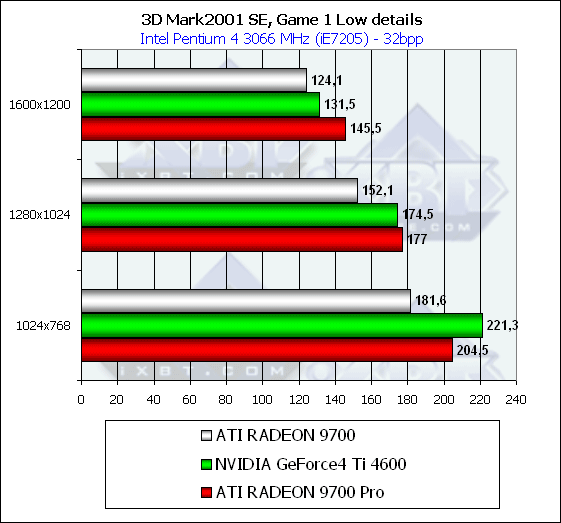

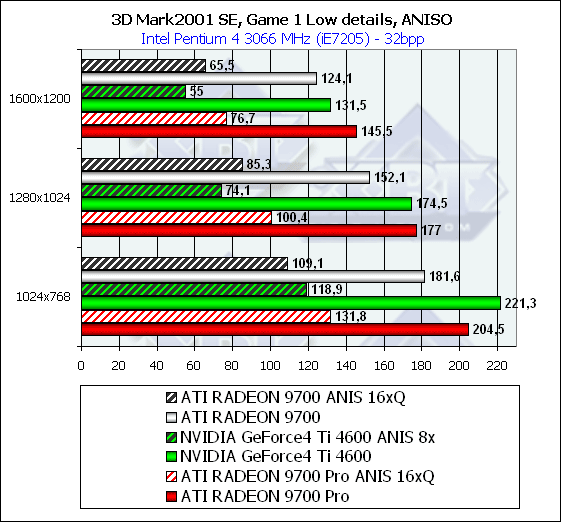


3DMark2001, Game2 Low details
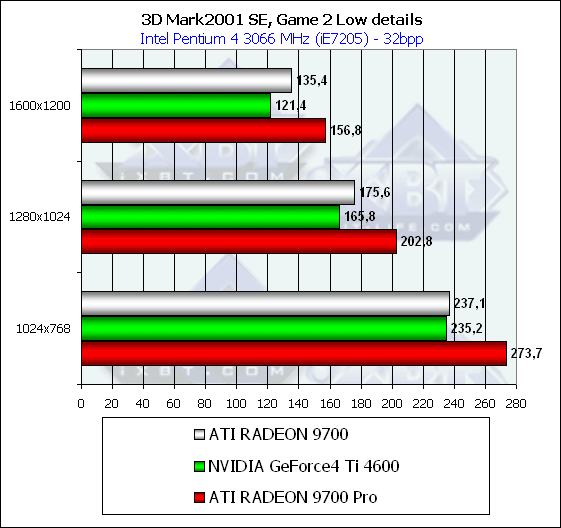

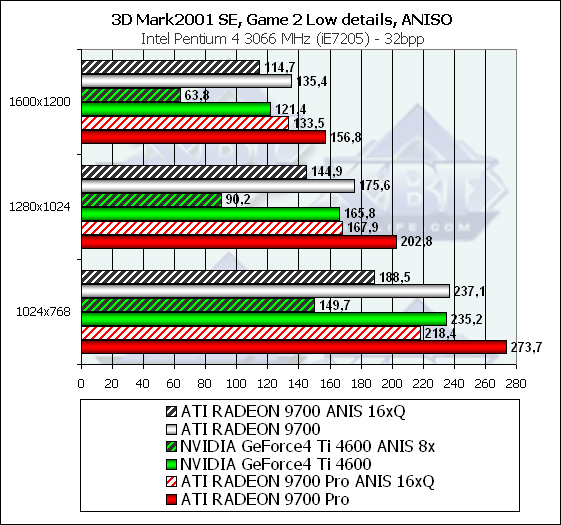


3DMark2001, Game3 Low details
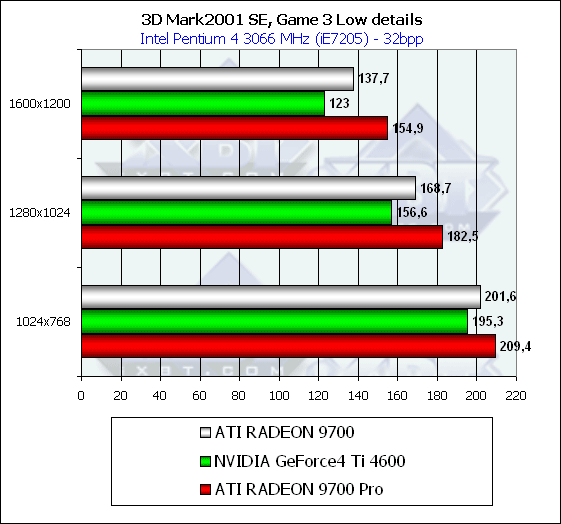

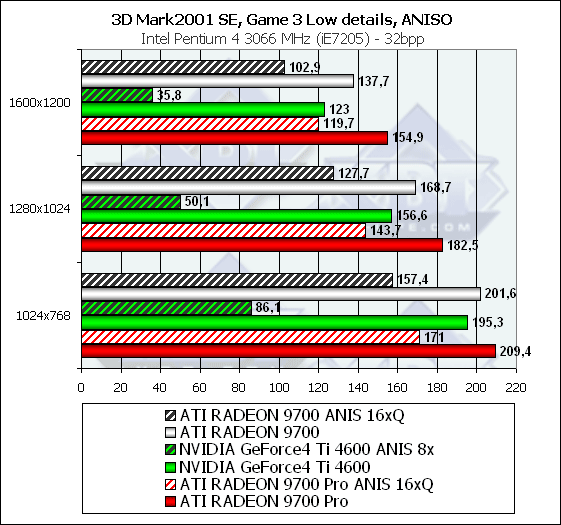


3DMark2001, Game4
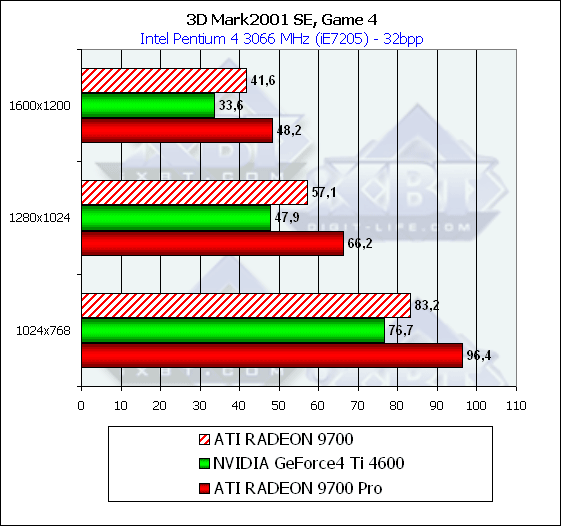

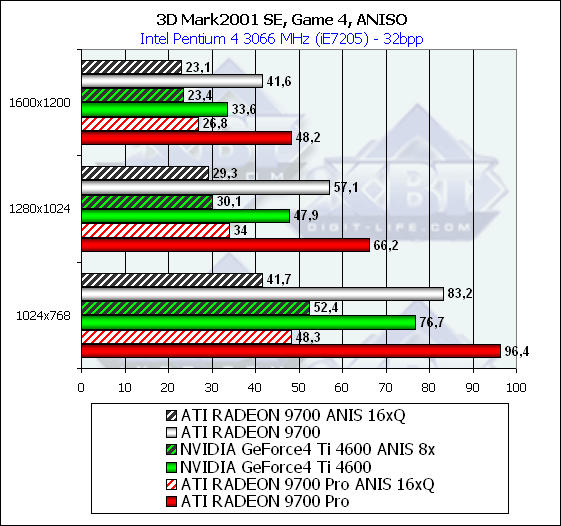


Until there is no GeForce FX 5800 Ultra on the market, all RADEON 9700
PRO cards take leading positions, and the RADEON 9700 competes successfully
against the GeForce4 Ti 4600. Of course, such cards must be estimated in
tough modes with AA and/or anisotropy.
Both cards performed excellently and worked stably. Remember that the
RADEON 9700 PRO Ultimate Edition card worked at its rated frequencies without
additional cooling.
But there is a downside: the first PCI slot's place is occupied by the
massive cooling system of this card. Besides, the heatsink significantly
projects on the back, that is why before buying such card make sure your
mainboard doesn't prevent installation of such sandwich.
Conclusion
We have tested two cards based on the ATI's reference design which showed
ordinary results in their classes. Note that the price for the Sapphire
Atlantis RADEON 9700 is very low (about $230-240). Due to its uniqueness
and the expensive Zalman's cooler, the Sapphire Atlantis RADEON 9700 PRO
Ultimate Edition will be dearer by $20-30 than its counterparts with a
usual cooler (by the way, the card will be supplied with a usual cooler
just in case).
Highs:
-
Excellent performance in 3D;
-
Nice build quality of the cards;
-
Reliability and stability;
-
No overheating of the Sapphire Atlantis RADEON 9700 PRO Ultimate Edition
at the rated frequencies;
Lows:
-
Pickups and ripples at a definite resolution on the RADEON 9700;
-
The sandwich of the Sapphire Atlantis RADEON 9700 PRO Ultimate Edition
won't suit all solutions.
Write a comment below. No registration needed!
|
|
 |
|
|
|


























